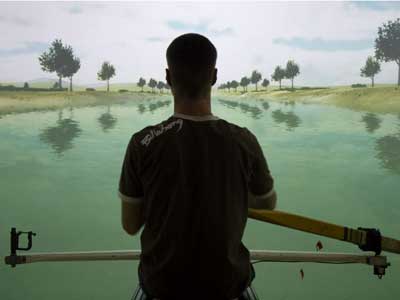To provide rowing practice for sportsmen and women, engineers at ETH Zurich have been perfecting the ideal rowing simulator that recreates training conditions as realistically as possible in a virtual environment.
The simulator comprises a rowing boat with its bow and stern sawn off and its oars shortened. The boat is surrounded by three screens, onto which a virtual riverscape is projected.
When the rower sits in the boat, the missing bow suddenly appears on the front screen and the extension of the oars becomes visible on the side screens.
The research group from the sensory-motor systems laboratory headed by Prof Robert Riener has been working on the rowing simulator for nearly a year.
The rowing boat is surrounded by a total of 112 speakers that play back splashes whenever the oars dip into the water and reproduce the crowd’s cheers.
10 cameras record the rower’s every movement and ropes connected to an electric motor are tied to the oars. When the rower plunges the oars into the water, the motor is activated and the sportsman feels the water resistance.
The simulator is supposed to guarantee as perfect a training session as possible. Peter Wolf, senior assistant at the laboratory, said: 'The training conditions of our rowing simulator are very close to those on the water. Training with our simulator is far more effective than a rowing ergometer, which has certain limitations when it comes to helping you perfect your technique.'

The rowing system takes crucial factors into consideration that do not exist otherwise on “dry land'. It can simulate competition situations with spectators and different wind conditions.
It also gauges physiological parameters such as breathing or heart rate and can correct any flaws in the sportsman’s strokes.
To fine-tune the simulator to the needs of professional sportsmen and women, the development team tests it regularly on rowers. Their feedback enables the team, which is made up of movement scientists, computer scientists, electrical engineers and mechanical engineers, to optimise the simulator’s performance.




Project to investigate hybrid approach to titanium manufacturing
What is this a hybrid of? Superplastic forming tends to be performed slowly as otherwise the behaviour is the hot creep that typifies hot...